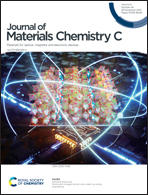Dual self-trapped exciton emission of (TBA)2Cu2I4: optical properties and high anti-water stability†
Abstract
Recently, zero-dimensional (0D) metal halides have made remarkable achievements in the field of optoelectronics due to their diverse structures and optical performances. Here, we report 0D (TBA)2Cu2I4 (TBA+ = tetrabutylammonium cation) single crystals (SCs), which shows a dual-emission band at 473 and 699 nm and a bright cool-white emission with a high photoluminescence quantum yield (PLQY) of 72.5% at room temperature (RT). The temperature-dependent emission spectra and Raman spectra show that a dual self-trapped exciton (STE) is present in this compound, and the external thermal energy can effectively regulate the population of STEs in the two emitting states, and thus the emission color can be changed from blue at a low temperature (78 K) to a cool-white emission at RT. More specifically, (TBA)2Cu2I4 SCs possess high anti-water stability, and can maintain highly efficient emission even if immersed in water for 24 hours. Also noteworthily, the high thermal stability, air stability and photostability of this component have also been proved.



 Please wait while we load your content...
Please wait while we load your content...